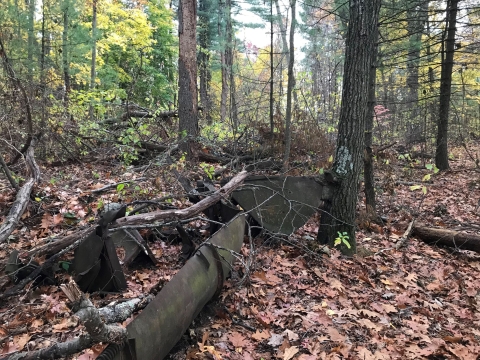TEWKSBURY – The Natural Resource Damages Trustee Council for the Sutton Brook Disposal Area Superfund Site has proposed to fund two projects located at Poplar Street and Mollie Drive in Tewksbury, Massachusetts, that would restore wetland, floodplain, and groundwater resources using $1.65 million in Natural Resource Damage Assessment and Restoration settlement funds. The restoration at Poplar Street will restore buried wetlands, reestablish connections between existing wetlands, and increase the floodplain storage capacity and the ability of the site to recharge groundwater. The restoration at Mollie Drive will restore buried wetlands, as well as restore floodplain storage capacity. The projects are more fully described in a draft restoration plan and environmental assessment released today for public comment through December 9, 2022.
The Natural Resource Trustee Council for the Sutton Brook Disposal Area Superfund Site comprises the Massachusetts Department of Environmental Protection (MassDEP), representing the Commonwealth’s Executive Office of Energy and Environmental Affairs, and the U.S. Fish and Wildlife Service, representing the U.S. Department of the Interior.
Through the Natural Resource Damage Assessment and Restoration Program, trustee councils identify the natural resources injured, determine the extent of the injuries, recover damages from those responsible, and plan and carry out natural resource restoration activities. The primary benefit of the program is that injured natural resources can be restored at no cost to the taxpayer. Instead, the parties responsible for the injuries pay for the restoration.
“When the natural resources of an ecosystem are damaged, the Commonwealth’s top priority is to ensure that those resources are fully restored,” said MassDEP Deputy Commissioner Paul Locke. “The two proposed projects will restore both the ecological and groundwater resources injured due to contamination from the site.”
“Our mission at the U.S. Fish and Wildlife Service is to work with our partners to conserve, protect, and enhance fish, wildlife, plants, and their habitats for the continuing benefit of the American people,” said Audrey Mayer, U.S. Fish and Wildlife Service’s New England Field Office supervisor. “These proposed projects will restore wetland and floodplain habitat for migratory birds and other wildlife, and improve public access to these natural areas for recreation and enjoyment.”
The draft restoration plan is available online at: https://www.mass.gov/service-details/natural-resource-damages-program-landfill-settlements-massdep
The public is encouraged to submit comments on the draft plan no later than December 9, 2022.
Comments can be submitted via e-mail or by mail to:
Andrew Major
U.S. Fish and Wildlife Service
70 Commercial Street Suite 300
Concord, NH 03301
E-mail: Andrew_Major@fws.gov
For more information on the Sutton Brook Superfund site, visit: https://cumulis.epa.gov/supercpad/cursites/csitinfo.cfm?id=0100686




